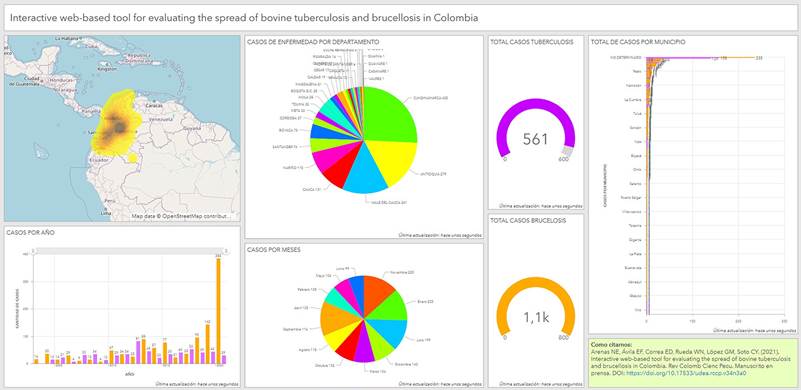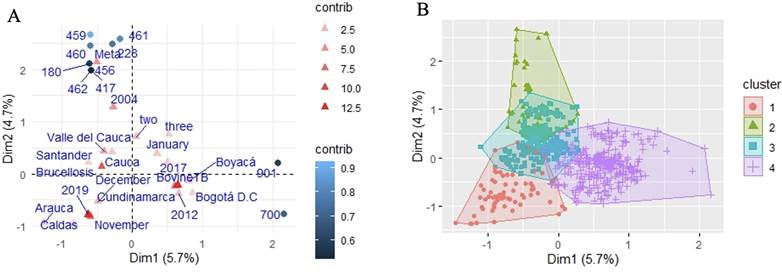Introduction
The spread of zoonotic pathogens has become one of the most concerning public health threats worldwide (Miller et al., 2017). Furthermore, zoonotic diseases represent a persistent problem in livestock production and animal health (Rohr et al., 2019). Accordingly, diseases such as bovine tuberculosis (BTB) and brucellosis have not been eradicated from many countries, remaining as sanitary control diseases that harm productivity, inflicting significant economic losses (Arenas and Moreno, 2016; Dafale et al., 2020). Low animal screening can delay an effective epidemiologic surveillance of BTB and brucellosis, affecting food safety in the long-term. In Colombia, prevalence of the disease fluctuates between 2.8 and 6.1% for brucellosis and remains undetermined for BTB, which may be partly due to control programs lacking suitable surveillance tools to track disease trends (Ávila-Granados et al., 2019).
The use of information and communications technologies is rapidly transforming infectious disease research regarding outbreaks, pathogen transmission, and the impact of public health policies (Parsons et al., 2014; Fletcher-Lartey and Caprarelli, 2016). Furthermore, since epidemiological information is increasing almost in real-time, disease tracking is becoming a pivotal strategy to identify the geographic origin and spread of zoonotic pathogens at the temporal-spatial scale (Dhewantara et al., 2019). Responding to the need of updated technologies for disease surveillance, we developed an online interactive platform, hosted by the Esri platform at Universidad de Cundinamarca to visualize and track reported cases of brucellosis and BTB in Colombia between years 2004 and 2019. The Colombian Agricultural and Livestock Institute (ICA; in Spanish, Instituto Colombiano Agropecuario) publishes weekly, monthly and annual bulletins reporting new cases and outbreaks of communicable diseases affecting animal health. Nevertheless, users cannot do a chronological follow-up of the brucellosis and TBB outbreaks to evaluate control strategies. Therefore, our platform was designed to offer public health authorities, researchers, and the livestock sector with a user-friendly tool to track cases reported by ICA and analyze information about national hotspots and case trends per year and province.
Materials and methods
Data collection
A retrospective observational study based on bovine cases of BTB and brucellosis (i.e., ani- mal communicable diseases) was conducted. We collected epidemiological data from ICA epidemi- ological bulletins, which are freely available online (https://www.ica.gov.co/boletines.aspx). Our da- taset included 529 BTB and 739 brucellosis case reports in Colombia during 15 years.
Platform design
Case information was stored as tuples to standardize an operational model, and include the defined-variables per rows for georeferencing and positioning in a spatial framework. A database management system was used to retrieve and manage the epidemiological data by using statistical models on an operations platform for ArcGIS coupled with the Esri´s Map-Viewer tool. Our Geographic Information Systems (GIS)-based tool was developed to show a series of variables, including disease (BTB or brucellosis), case number, location by province, and year (2004-2019). The tool also enables searching by case number per municipality or generate a monthly report to infer a potential disease seasonality (Figure 1). The platform information is displayed in Spanish.
Statistical analysis
Data analysis was performed using a multiple correspondence analysis (MCA) and a Chisquare test using the Factominer and Factoextra packages of R software (v3.6). Statistical differences were calculated at p<0.001 significance level.

Figure 1 Platform visualization for epidemiological surveillance of BTB and brucellosis in Colombia. Right panel: case number per municipality; central-upper panel: total diseases (BTB and brucellosis) per province; central-lower panel: case frequency per month; upper-left panel: Colombia´s interactive map of case rate; and lower-left panel: total cases per year (in purple for BTB and yellow for brucellosis).
Results
Disease rates per province were determined by collecting data from weekly situation reports. According to data analysis, more than one third of the disease burden in Colombia regarding BTB and brucellosis was located in Cundinamarca province with 345 cases (27.2%), Valle del Cauca province with 227 cases (17.9%), and Antioquia province with 160 cases (12.6%). Further analyses showed that Cundinamarca has the highest prevalence of BTB with 304 cases (57.5%), specifically in Zipaquirá municipality with 133 cumulative cases (43.7%). Valle del Cauca showed the highest number of brucellosis cases with 223 (30.2%), many of these were focused in Cartago municipality with 18 cases (8%; Figure 2A).

Figure 2 Correspondence analysis for BTB and brucellosis between years 2004 and 2019 in Colombia. A. Scatter plot of each single variable contribution for disease transmission. The red triangles and blue color spots indicate data distribution. B. Clustering representation for variables contributing to BTB and brucellosis spread.
The MCA analysis confirmed that Cundinamarca and Boyacá had high BTB rates and increased detection in January 2012 (Cluster 4). Brucellosis was high in Santander, Valle del Cauca, and Cauca in 2004, and a temporal outbreak in Caldas during 2019 was detected (Cluster 3) (Figure 2B). The MCA analysis confirmed the accuracy of our GIS-based tool. Consistently, the Chi-square test showed that disease, province, year, month, and rate were highly significant (p<0.001), and province was the most critically associated with presence of both diseases. Regarding the temporal scale, BTB detection was higher during 2012 (n = 91) and a brucellosis peak occurred in 2019 (n= 138) with monthly increases in January, July, and November. These findings indicate that our platform can provide accurate information about disease seasonality.
Discussion
Our interactive panel displays the epidemiological information that is consistent with the map representation, where foci are concentrated towards the Colombian Andean and Pacific regions with sporadic cases across other areas (Jojoa-Jojoa et al., 2016). However, previous studies suggest that the Colombian Orinoquía region was an endemic area for brucellosis between 2006-2012 (Cárdenas et al., 2018). Those insights can be relevant to reinforce disease control or animal testing and even implement actions during the emergence of outbreaks associated with climate change (Yoon et al., 2014; Cárdenas et al., 2018).
We suggest that BTB and brucellosis are spreading actively since 2004 in temporal outbreaks, which can be explained by low screening and lack of suitable detection tools (Henrioud, 2011; Arenas et al., 2017). The main causes that influence the active spread of BTB and brucellosis in Colombia could be attributable to illegal animal traffic from neighboring countries, deficiencies in intensive testing plans, lack of socio-economic benefits and trade-offs for smallholder milk farmers with positive animals, and animal movement or insemination procedures between non-certified farms (Jojoa- Jojoa et al., 2016; Yahyaoui-Azami et al., 2018; Ávila-Granados et al., 2019; Cárdenas et al., 2019). Remarkably, our platform can allow users to infer potential epidemiological links regarding BTB and brucellosis cases (Fletcher-Lartey and Caprarelli, 2016). Furthermore, it provides information on how BTB and brucellosis spread in the field, as well as an opportunity to improve vaccination plans between geographical boundaries, increase diagnostic practices, develop control strategies in farms, and locate hotspot areas for evidence- based decision making in surveillance protocols (Jacquez, 2010).
Overall, we expect that our GIS-based tool will support disease control strategies, identification of outbreak sources, and contribute to future policies to eradicate BTB and brucellosis. We proposed that the database management system can be updated monthly by ICA and shared with the World Organization for Animal Health (OIE), and OIRSA (in Spanish, Organismo Internacional Regional de Sanidad Agropecuaria). Finally, our platform may lead to new strategies for countering not only these infectious diseases but also other zoonoses that can spread extensively across countries in South America. The platform is available at: https://arcg.is/1uvSLv














